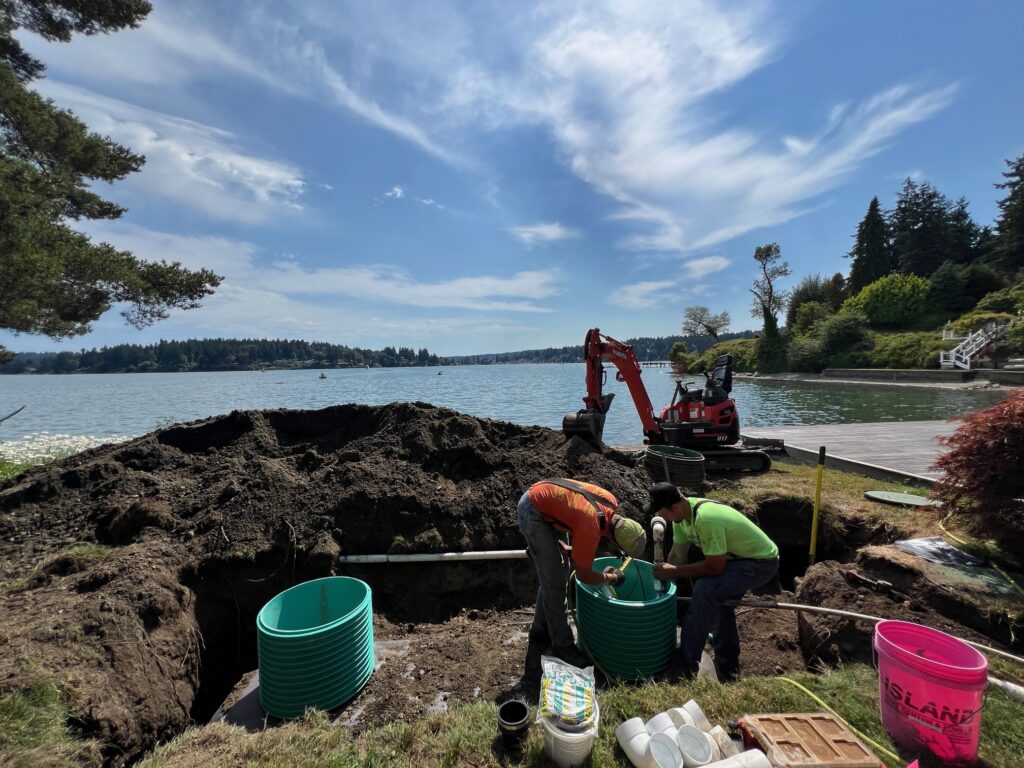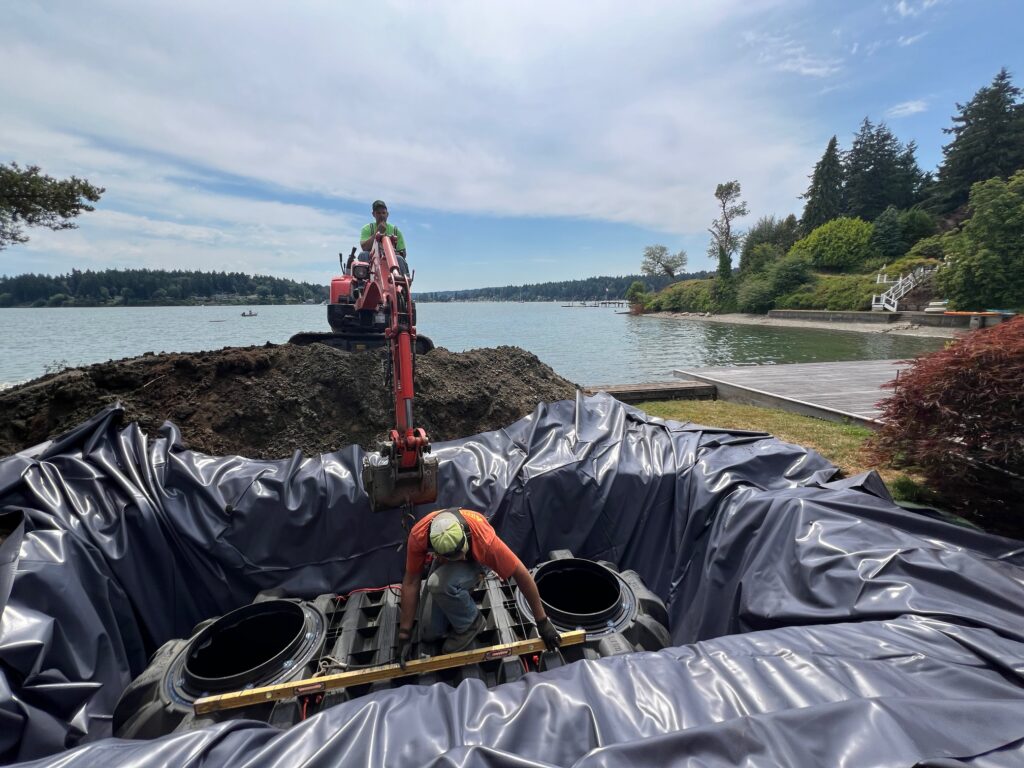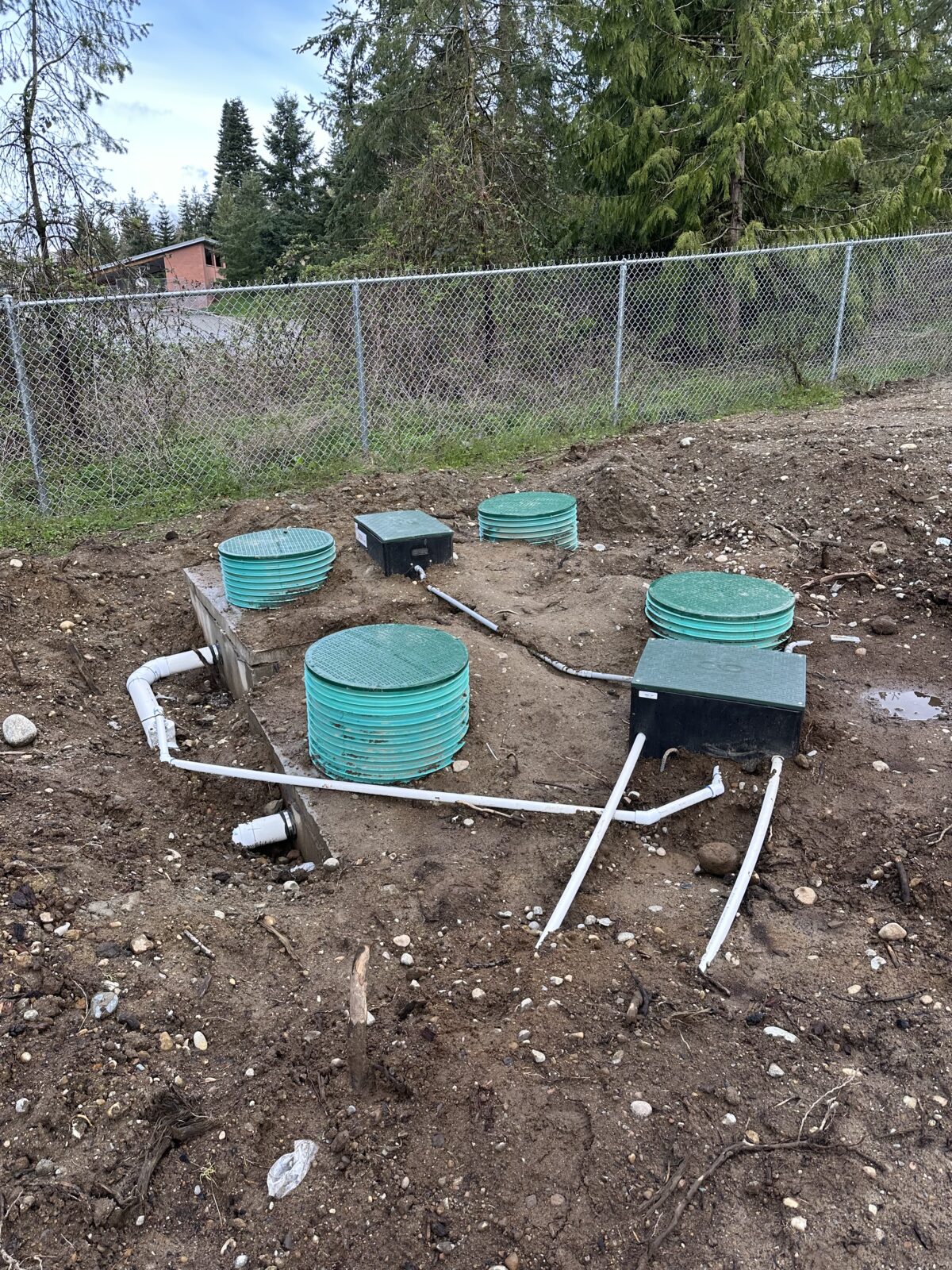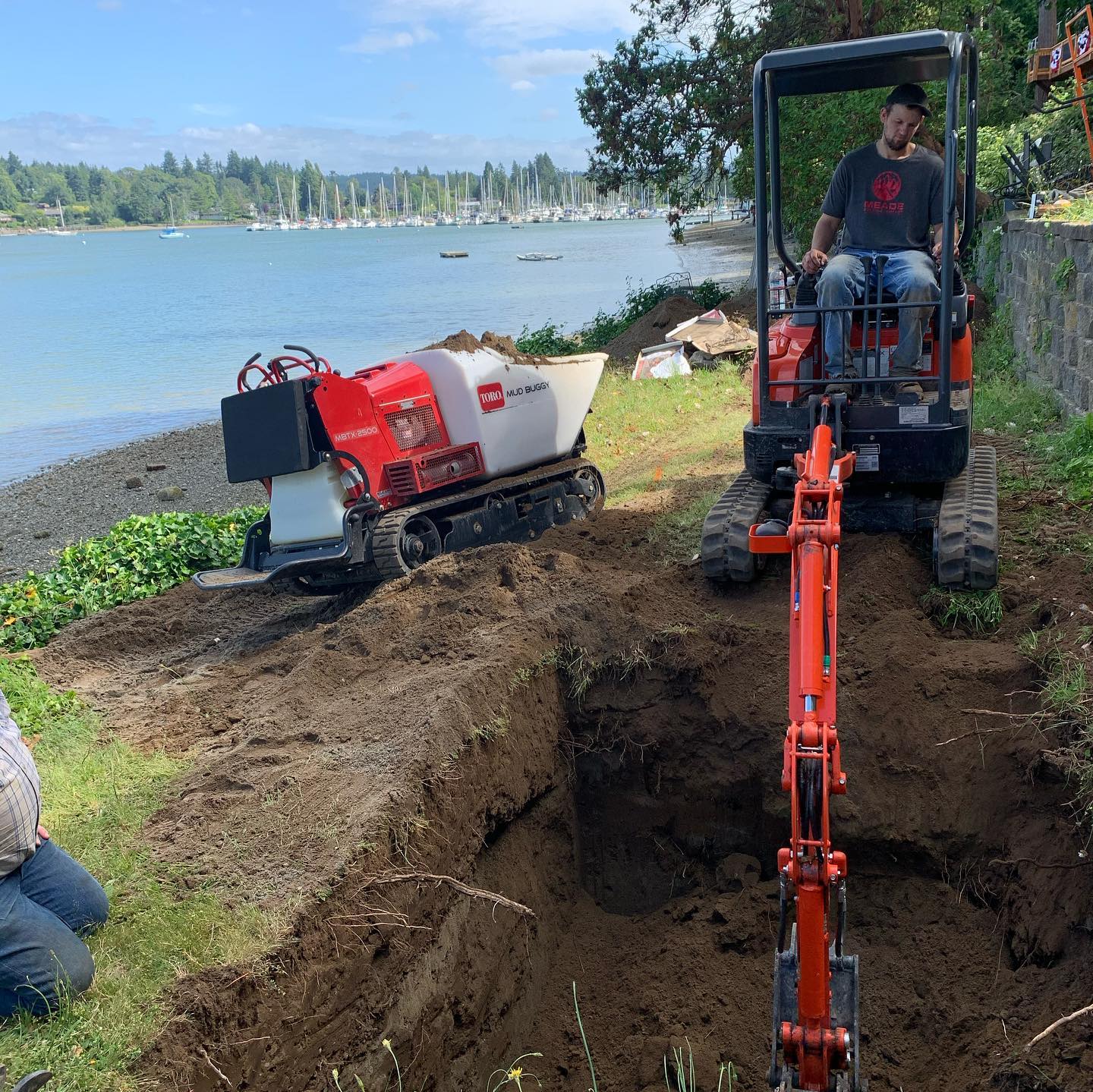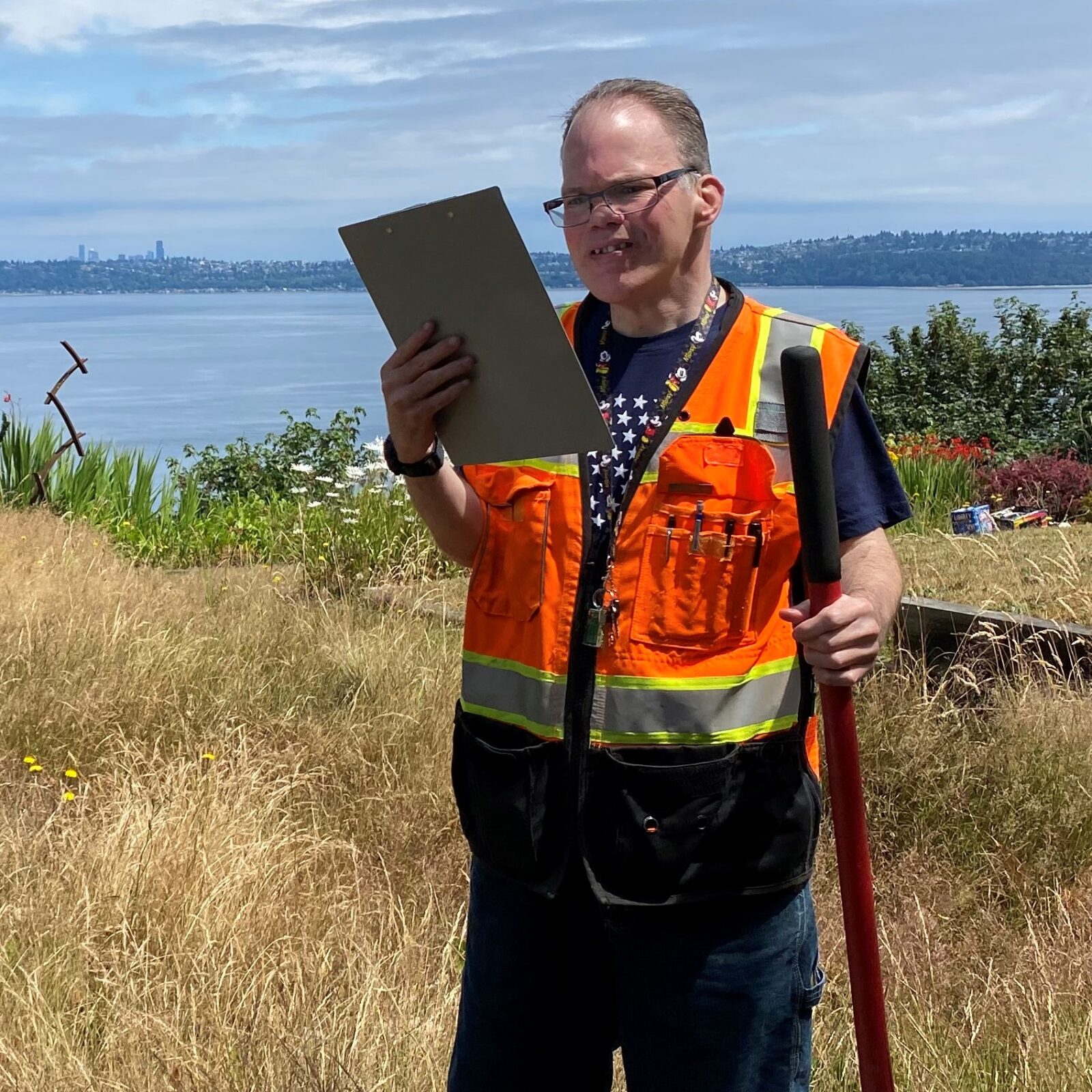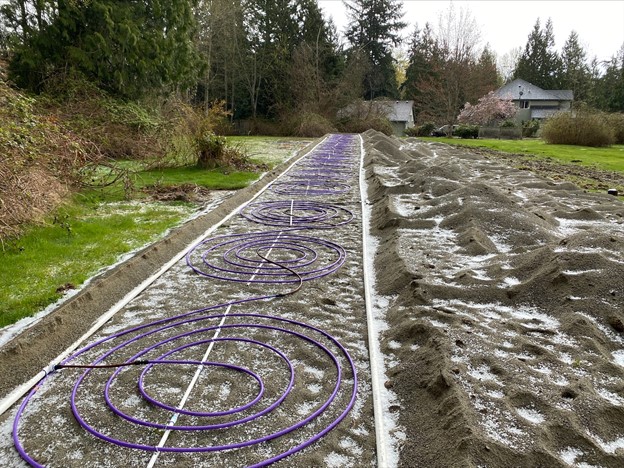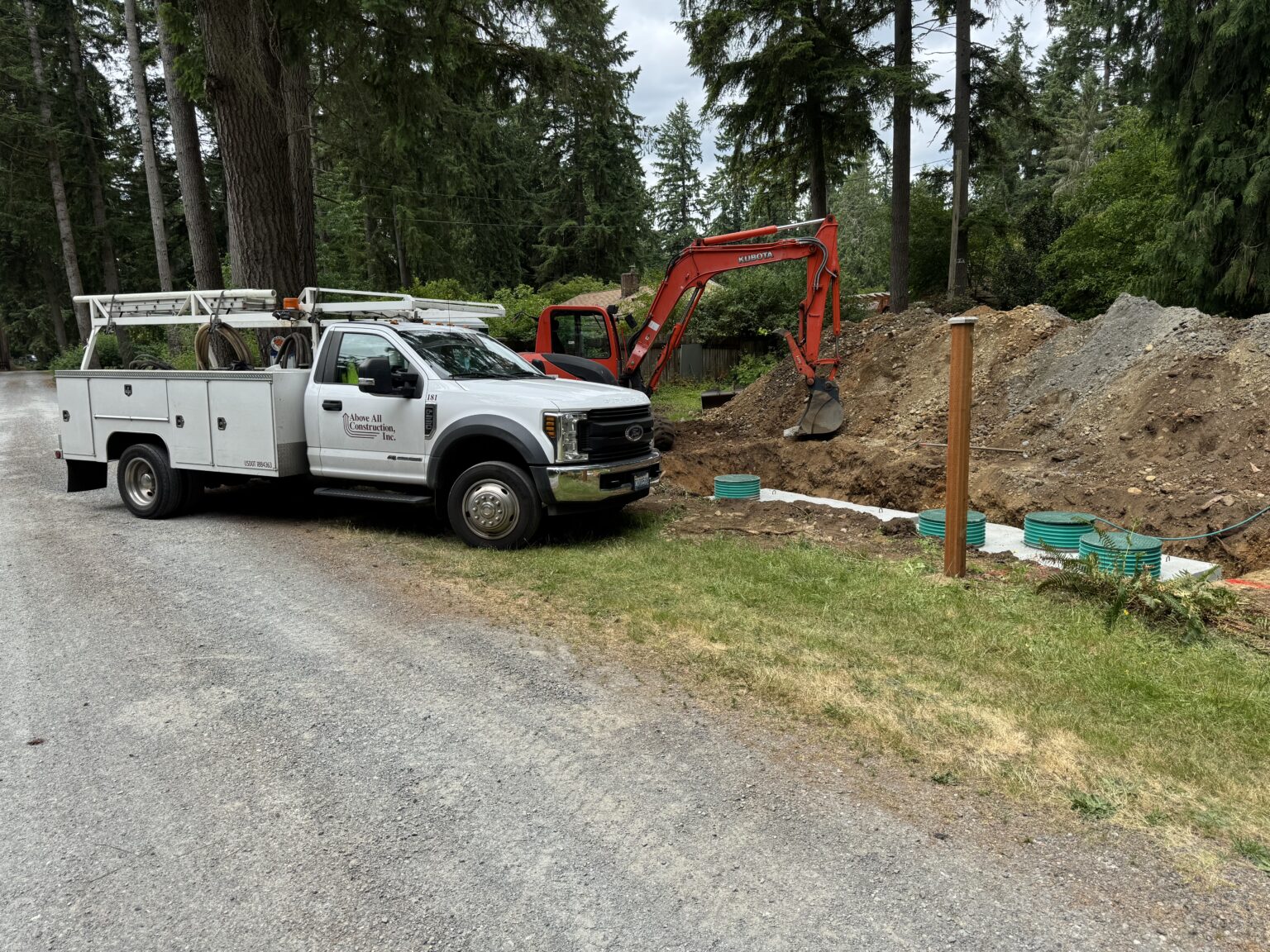
Our Blog
Our blog is a place for interesting infomation concerning our industry and our projects!
Planning to build your dream home or replace an aging septic system in King County is an exciting venture. But before you can break ground, there are critical steps that ensure your on-site sewage system (OSS) is safe, effective, and compliant with local health regulations. Two of the most important, yet often misunderstood, components are the soil log test and the long-term maintenance plan.
These aren’t just bureaucratic checkboxes; they are the foundational elements of a successful septic design. They protect your investment, your family’s health, and the pristine natural environment of King County. This guide will walk you through why these steps are non-negotiable and how they shape your entire project, from initial design to decades of reliable service.
Understanding Soil Log Tests & Permit Requirements
The journey to a new septic system begins in the ground itself. King County Public Health has stringent requirements to ensure that wastewater is treated effectively on-site, and it all starts with a deep understanding of your property’s soil.
What is a soil log test?
A soil log test is a detailed, professional evaluation of your soil profile. It’s much more than the older, less reliable “perc test.” A licensed septic designer or soil scientist digs one or more test pits, typically 6 to 8 feet deep, to visually inspect and document the different layers of soil, known as horizons.
During this evaluation, the professional identifies:
- Soil Type & Texture: The mix of sand, silt, and clay, which determines how quickly or slowly wastewater (effluent) will filter through.
- Soil Structure & Color: Clues that indicate how well the soil is aerated and drained.
- Evidence of Seasonal Water Table: The presence of mottling (patches of different colors) reveals the highest point the water table reaches during the wet season. The drain field must be installed a specific vertical distance above this level.
- Restrictive Layers: The depth of any hardpan, dense glacial till, or bedrock that could impede water flow and prevent proper treatment.
This data is meticulously logged and becomes the blueprint for your septic system design, dictating the type, size, and location of your drain field.
Why soil logs are required by King County Health
King County Public Health mandates soil logs for one primary reason: to protect public health and the environment. Your soil is the final and most critical component in the wastewater treatment process. A properly functioning drain field allows beneficial microbes in the soil to naturally break down and purify effluent before it reaches groundwater, streams, or Puget Sound.
A soil log provides verifiable proof that your property’s soil conditions are suitable for this task. Without this scientific assessment, you could install a system that fails prematurely, leading to:
- Contamination of drinking water wells.
- Pollution of nearby surface waters.
- Public health hazards from sewage surfacing in your yard.
- Costly emergency repairs and potential legal liability.
Submitting a complete and professional soil log is a non-negotiable first step to getting your septic design application approved.
How long does a permit take in King County?
The timeline for securing a septic installation permit in King County can vary. It’s a multi-step process:
- Designer Engagement & Site Work: Scheduling a designer for the site evaluation and soil log testing can take 1-3 weeks, depending on their availability.
- System Design: After the soil log is complete, your designer will create the detailed plans. This typically takes another 2-4 weeks, depending on the complexity of the system required.
- County Review: Once submitted, King County Public Health reviews the application. This is the most variable part of the timeline and can range from several weeks to a few months. Review times depend on the department’s current workload and the completeness of your application.
Pro Tip: The best way to shorten the overall timeline is to submit a thorough, accurate, and fully compliant application package. Working with an experienced local designer is the key to avoiding delays caused by requests for more information.
Maintenance Planning – How It Impacts Septic Design
A septic system is not a “set it and forget it” utility. It’s a living, breathing ecosystem that requires regular care. A great designer doesn’t just plan for installation; they plan for the entire lifecycle of your system, and this forward-thinking approach starts at the design phase.
How often to inspect a septic system?
King County regulations specify minimum inspection frequencies based on your system type.
- Gravity Systems: These are the simplest type and generally require an inspection by a qualified professional at least once every three years.
- Pressure Distribution, Mound, Sand Filter, and Proprietary Systems: These more complex systems involve pumps, floats, and other mechanical components. They require an inspection every year to ensure all parts are functioning correctly.
Note that an inspection is different from pumping. You only need to pump your tank when the inspection shows that the sludge and scum layers have reached a certain level.
How to extend septic system life through design choices
Smart design is your first and best opportunity to ensure a long, trouble-free life for your septic system. An experienced designer will incorporate features that simplify maintenance and enhance longevity:
- Risers and Lids to Grade: Installing watertight risers from your tank and pump chamber to the ground surface provides easy access for inspectors and pumpers without digging up your yard.
- System Type Selection: The design will be tailored to your property’s soil conditions and your family’s needs. A designer can explain the long-term maintenance trade-offs between a simpler gravity system and a more complex aerobic treatment unit (ATU).
- Reserve Area Designation: King County requires that every new system design includes a designated “reserve area.” This is a suitable location for a full replacement drain field, ensuring you have a pre-approved solution if the primary field fails decades from now.
- Durable Components: Using high-quality tanks, pipes, and pumps can significantly reduce the risk of premature failure.
What maintenance plan is included in design process
As part of your approved design package, your designer will provide you with a detailed Operations and Maintenance (O&M) Manual. This isn’t a generic brochure; it’s a customized guide for your specific system. It will include:
- An “as-built” diagram showing the location of all components.
- The manufacturer’s specifications for your tank, pump, and other parts.
- A clear schedule for required inspections.
- A checklist for what the homeowner should monitor (e.g., avoiding leaks, protecting the drain field).
- A log for you and your maintenance provider to record all inspections, pumping, and repairs.
This document is required by the Health Department and serves as your official guide to keeping the system compliant and functional.
Cost & Timeline Considerations
Budgeting and scheduling are top priorities for any homeowner. Here’s what to expect when it comes to the design and permitting phase.
How much does septic design cost in King County?
The cost for a septic design in King County can range significantly, typically from $3,000 to $8,000 or more. The final price depends on several factors:
- Site Complexity: A flat, open lot with ideal soil is less complex to design for than a steep, wooded, or waterfront property.
- System Type: A simple gravity system design will cost less than a complex mound or proprietary system that requires more detailed engineering calculations.
- Included Services: The fee covers the designer’s time for site visits, soil log evaluation, detailed CAD drawings, and the preparation and submission of the permit application package.
It’s crucial to view this not as a cost, but as an investment in a properly functioning system that avoids the far greater expense of failure.
Permit timeline vs. installation schedule
It’s essential to understand the sequence of events. You cannot begin construction until you have the approved permit from King County Public Health in your hands.
The Correct Sequence:
- Design & Permitting Phase (Weeks to Months): This includes all the steps from the initial soil log to receiving the final permit.
- Installer Bidding & Selection (1-3 Weeks): Once the permit is approved, you can provide the official plans to qualified installers to get accurate bids.
- Installation Phase (Days to Weeks): The actual installation is relatively fast but is dependent on weather and the installer’s schedule.
Critical Advice: Do not hire or schedule an installer until your design and permit are fully approved. Any changes required by the Health Department could alter the design and affect the installer’s bid.
Compliance & Regulatory Tips
Navigating the regulatory landscape of King County can be challenging. An experienced designer is your best ally in ensuring a smooth process.
Common permitting issues and how to avoid them
Most permit delays are avoidable. Here are the most common pitfalls:
- Incomplete Applications: Missing forms, incorrect information, or failure to pay the correct fees.
- Setback Violations: The design fails to meet the minimum required distances from wells, property lines, buildings, lakes, or streams.
- Unsuitable Design: The proposed system type is not appropriate for the soil conditions identified in the log.
- Ignoring Site Constraints: The design doesn’t account for steep slopes, wetlands, or other critical areas on the property.
The Solution: The single best way to avoid these issues is to partner with a reputable, local septic designer who has a deep understanding of King County’s specific codes and a good working relationship with the Health Department.
Final Recommendations
Starting your septic project on the right foot with a proper evaluation and a long-term mindset is the key to success.
Getting started with evaluation and maintenance
Everything begins with a single step: a professional site evaluation. A licensed septice designer like us will visit your property, discuss your plans, assess the landscape, and determine the best locations for soil log test pits. This initial consultation provides the essential information needed to move forward with confidence.
Maintaining your septic system is crucial for its long-term performance and avoiding costly repairs. In King and Snohomish Counties, factors like soil composition, property size, and seasonal climate can impact how your system operates. Proper maintenance helps prevent common issues such as clogs, backups, and system failures, ensuring your septic system works efficiently for years to come. Here are essential septic system maintenance tips tailored to homeowners in these counties.
1. Regular Septic Tank Pumping
Septic tanks need to be pumped regularly to prevent the build-up of solids, which can lead to system clogs and drain field failure. The frequency of pumping depends on the size of the tank and household usage, but a general rule of thumb is to pump every 3-5 years. In King and Snohomish Counties, where the soil composition can vary, regular pumping is even more crucial to prevent soil saturation and potential contamination of local water sources.
If your system has already failed, read our guide on what to do when facing a failed septic system for steps on managing the situation and planning for repairs.
2. Be Mindful of Water Usage
Excessive water use can overwhelm your septic system, leading to poor treatment of wastewater. Homeowners in King and Snohomish Counties should be particularly mindful of water usage, especially during the rainy season when soil saturation is higher. Simple changes, such as fixing leaky faucets, installing low-flow toilets, and spreading out laundry loads throughout the week, can reduce the strain on your septic system.
For properties with high water usage, consider upgrading to a system like the NUWater BNR600, which is designed to handle larger volumes of wastewater efficiently.
3. Avoid Flushing Non-Biodegradable Items
Your septic system is designed to handle human waste and toilet paper, but flushing non-biodegradable items can cause clogs and damage to the system. Avoid flushing wipes, feminine hygiene products, paper towels, and other items that do not break down easily. Doing so prevents blockages in the pipes and protects your drain field from potential contamination.
4. Protect the Drain Field
The drain field is a critical part of your septic system, responsible for filtering and dispersing wastewater into the soil. To ensure its efficiency:
- Keep the area clear: Do not park vehicles or place heavy objects on the drain field, as this can compact the soil and reduce its filtration capacity.
- Divert rainwater: Ensure that gutters, downspouts, and other drainage systems direct water away from the drain field to prevent oversaturation.
- Plant grass, not trees: If you wish to landscape near the drain field, opt for grass or shallow-rooted plants. Avoid planting trees and shrubs with deep roots that can invade and damage the pipes.
For properties in King and Snohomish Counties with challenging soil conditions, upgrading to an alternative system like OSCAR subsurface drip irrigation can help optimize the drain field’s performance.
5. Perform Regular Inspections
Routine inspections are vital for identifying potential problems before they become serious issues. An annual inspection can help spot signs of system failure, such as slow drains, foul odors, or pooling water around the drain field. Professional inspections can also provide valuable information on the health of your system and offer recommendations for repairs or upgrades.
Our team provides feasibility and soil log testing to assess the condition of your septic system and soil, helping homeowners make informed decisions about maintenance or potential upgrades.
6. Use Septic-Safe Products
Choose septic-safe household products, including laundry detergents, cleaning agents, and toilet paper. Many conventional products contain chemicals that can disrupt the bacterial balance in your septic tank, slowing down the breakdown of waste. Opt for products labeled as “septic-safe” to maintain the proper functioning of your system.
7. Be Cautious with Garbage Disposals
While garbage disposals are convenient, they add an extra load to your septic system. Food waste, grease, and other solids can accumulate in the tank, requiring more frequent pumping and increasing the risk of clogs. If you use a garbage disposal, be sure to pump your tank more regularly to avoid issues.
If your septic system struggles with solid waste management, consider upgrading to a system that can handle increased loads efficiently, such as our sand-lined drip irrigation systems.
8. Watch for Warning Signs of Failure
Keep an eye out for common warning signs that indicate your septic system may be in trouble, including:
- Slow draining sinks, showers, and toilets
- Foul odors in your home or around the drain field
- Pooling water or damp spots in your yard
- Sewage backups into the home
If you notice any of these signs, it’s crucial to address the problem promptly. Visit our blog on what to do when facing a failed septic system for guidance on managing a failing system and planning necessary repairs.
Maintaining Your Septic System with Our Help
Proper maintenance is key to extending the life of your septic system and ensuring it operates effectively. Our team specializes in designing and maintaining septic systems tailored to the unique conditions of King and Snohomish Counties. From regular inspections to repairs and upgrades, we offer a comprehensive range of services to keep your system in top condition.
For more tips and information on septic system maintenance, explore our blog, where we discuss various installation projects, maintenance advice, and updates on our services in the region.
If you’re experiencing issues with your septic system or need assistance with maintenance, contact us today. For emergencies, text 911 to 425-248-1140, and we will get back to you within 24 hours. Proper septic system maintenance not only protects your property but also safeguards the environment and water resources in King and Snohomish Counties.
Soil composition is one of the most crucial factors influencing the design and effectiveness of a septic system. In King and Snohomish Counties, soil types can vary greatly, affecting how wastewater is treated and absorbed. Understanding the unique soil conditions on your property is essential to ensure compliance with local regulations and to choose the most efficient septic system for long-term performance. Here’s how soil composition impacts septic system design in these counties and what you should consider when planning your installation.
Why Soil Composition Matters in Septic System Design
Septic systems rely on soil to naturally filter and treat wastewater before it reaches the groundwater. The soil’s texture, structure, and drainage capacity determine how well it can perform this vital function. When the soil isn’t suitable, it can lead to system failure, groundwater contamination, or costly repairs. That’s why King and Snohomish Counties have specific regulations that require thorough soil evaluation before designing and installing a septic system.
Common Soil Types in King and Snohomish Counties
- Sandy Soils: Sandy soils have high permeability, allowing wastewater to filter through quickly. While this helps prevent pooling and backups, it may not provide enough treatment time for the wastewater to break down harmful bacteria and contaminants. To address this, advanced treatment systems like sand-lined drip irrigation or other filtration systems are often required.
- Clay Soils: Clay-rich soils have poor drainage and low permeability, meaning water takes longer to pass through. These conditions can lead to pooling water and system failure if not properly managed. For properties with clay-heavy soil, alternative systems like OSCAR systems or mounded systems are often more effective, as they provide an engineered solution to manage wastewater.
- Loamy Soils: Loamy soils are generally considered ideal for septic systems because they offer a good balance of permeability and water retention. The combination of sand, silt, and clay in loamy soils allows for effective filtration and treatment of wastewater. Properties with loamy soil can often support traditional septic systems, such as gravity or low-pressure distribution.
- Gravelly or Rocky Soils: These soils can present a challenge for septic system design due to their large pore spaces, which allow wastewater to move too quickly through the soil. This rapid movement can result in inadequate filtration and potential contamination of groundwater. For properties with gravelly soils, systems like NUWater BNR600 provide advanced treatment to ensure water safety.
Soil Testing and Feasibility Studies
Before any septic system design, a thorough soil evaluation is required to assess the site’s suitability. Soil testing involves digging soil log holes to examine the soil layers, texture, and depth to the water table. This information helps determine the type of septic system best suited for the property.
We offer detailed soil log testing and feasibility studies to guide homeowners in selecting the appropriate system. Our team is well-versed in King and Snohomish Counties’ specific regulations, ensuring that your system will comply with local health department standards.
How Soil Conditions Affect System Choice
- Conventional Systems: Ideal for properties with loamy or sandy soils and sufficient space, conventional systems like gravity distribution or pump-to-gravity systems work effectively when the soil can naturally filter wastewater. However, soil depth and seasonal water tables must also be considered during the design process. Learn more about our approach to conventional septic system installations in various projects across the counties.
- Alternative Systems: For properties with challenging soil conditions—such as clay-rich or gravelly soils—alternative septic systems provide advanced treatment. Systems like the OSCAR subsurface drip irrigation or sand-lined drip irrigation allow for the effective treatment and dispersion of wastewater, even in less-than-ideal soils. These systems are custom-designed to work with the soil composition and property layout, ensuring compliance with county regulations.
- Mounded and Raised Systems: For sites with shallow soil layers or high water tables, mounded systems can create an artificial drain field above the natural soil, providing adequate filtration and treatment. This method is particularly useful in areas with poor drainage or compacted soils commonly found in some parts of King and Snohomish Counties.
Our Soil-Centric Approach to Septic Design
With over 30 years of experience in septic system design, we begin every project with a site-specific soil evaluation to guide the system selection process. Our designs focus on optimizing the soil’s natural filtration capacity while meeting all local health department requirements. We understand that each property in King and Snohomish Counties is unique, and our custom-tailored designs reflect this reality.
For more information on how soil conditions impact septic system design or to schedule a feasibility study, explore our recent blog posts that showcase various installation projects. Whether you need a new septic system for a property in Woodinville, Lynnwood, or Vashon Island, our expertise ensures that you receive a system suited for your soil conditions and property layout.
If you need assistance in choosing the right septic system or have questions about soil testing on your property, contact us today. For urgent repairs, text 911 to 425-248-1140, and we’ll respond within 24 hours.
By understanding how soil composition affects septic system design, you can make informed decisions that ensure the long-term performance of your system while protecting the environment.
Septic systems play a crucial role in maintaining a healthy environment on your property. However, over time, even the best-designed systems can experience wear and tear, leading to inefficiencies and potential failures. Identifying the early signs that your septic system needs an upgrade can prevent costly repairs and health hazards. Here are the top five signs indicating it’s time to consider upgrading your septic system in King and Snohomish Counties.
1. Slow Draining Sinks, Toilets, and Showers
If you notice that your sinks, toilets, or showers are draining slower than usual, it might be a sign of septic system issues. This slowdown can indicate a clog in your pipes or that your septic tank is too full. While minor clogs can sometimes be addressed with professional cleaning, persistent drainage problems often suggest a larger issue that may require a septic system upgrade.
For more insight into what happens when systems fail and how to address them, check out our blog on what to do when facing a failed septic system.
2. Foul Odors in Your Yard or Home
A properly functioning septic system should not produce noticeable odors. If you smell foul sewage odors around your property, especially near the septic tank or drain field, it could indicate that the system is failing. This issue may result from a full septic tank, broken pipes, or an outdated system. Addressing these odors promptly with a system upgrade can help avoid more extensive damage.
Read about our experience with specific septic system installations in Snohomish County to learn how proper design and installation can prevent such issues.
3. Pooling Water in Your Yard
Water pooling around the septic tank or drain field is a clear indication that your system is not processing wastewater efficiently. This problem can arise when the drain field becomes saturated or the tank is too full. In King and Snohomish Counties, where soil conditions and wet climates often challenge traditional systems, upgrading to a more efficient solution like an OSCAR system can be a long-term fix for water pooling problems.
4. Frequent Backups and Overflows
Frequent backups in your home’s plumbing are a serious red flag that your septic system might be failing. When your septic tank reaches its maximum capacity or the drain field stops absorbing wastewater, the sewage will have nowhere to go, resulting in backups into your home. Upgrading to a more advanced septic system, such as a sand-lined drip irrigation system, can handle higher wastewater loads and prevent backups.
5. Old Septic System (20+ Years)
Septic systems typically have a lifespan of 20-30 years, depending on usage and maintenance. If your septic system is older, it may be time to upgrade to a newer model that can handle current household demands more efficiently. In areas like King and Snohomish Counties, where regulations and soil conditions have evolved over the years, a modern septic system design is often required. Our team can help you assess the state of your current system and recommend an upgrade, such as the installation of a NUWater BNR600 system for enhanced wastewater treatment.
How We Can Help
If you’re experiencing any of these issues, it’s essential to consult with a professional septic system design company. We specialize in upgrading septic systems to ensure compliance with county regulations and environmental standards. With over 30 years of experience in King and Snohomish Counties, we provide timely and cost-effective services tailored to your property’s specific needs.
For more information on our repair and installation services, visit our blog. We offer detailed insights into recent projects, including feasibility and soil log testing, OSCAR system installations, and more.
If you suspect your septic system needs an upgrade or repair, don’t wait! Contact us today, or for emergencies, text 911 to 425-248-1140, and we will get back to you within 24 hours.
Selecting the right septic system for your property is crucial, as it ensures long-term performance, low maintenance costs, and compliance with county regulations. In King and Snohomish Counties, where soil conditions, property sizes, and local regulations vary widely, understanding the different options available can help you make an informed decision. Here’s a comprehensive guide to help you choose the best septic system for your needs.
Factors to Consider When Choosing a Septic System
- Soil Composition and Site Evaluation
- The soil on your property plays a critical role in septic system selection. Proper drainage and filtration are essential for the system’s effectiveness. Before any design, a soil log test and site evaluation are necessary to determine the soil type, depth, and water table level. We provide soil log testing and feasibility studies as part of our services to ensure the chosen system is suitable for your site’s specific conditions.
- Property Size and Layout
- The size and layout of your property will influence the type of septic system you need. For properties with ample space and good soil conditions, a conventional gravity system might be the best choice. However, properties with limited space, steep slopes, or poor soil conditions may require an alternative system, such as an OSCAR system or a sand-lined drip irrigation system.
- Water Usage
- Your household’s water usage impacts the size and type of septic system you need. Homes with larger families or high water usage may require advanced treatment systems that can handle increased wastewater volumes, such as the NUWater BNR600 system. These systems are designed to provide effective wastewater treatment even under high usage conditions.
- Regulations and Permitting
- Both King and Snohomish Counties have specific regulations regarding septic system installation, including permitting, setback requirements, and environmental protections. It’s crucial to work with a professional design company that is familiar with local regulations. Our team has over 30 years of experience navigating the permitting process and ensuring compliance with county health department standards.
Types of Septic Systems We Design
- Conventional Septic Systems
- These systems are ideal for properties with suitable soil conditions and adequate space. They use gravity to move wastewater through the tank and into a drain field for natural filtration. We offer a variety of conventional systems, including:
- Gravity Distribution
- Pump to Gravity
- Low Pressure Distribution
- These systems are ideal for properties with suitable soil conditions and adequate space. They use gravity to move wastewater through the tank and into a drain field for natural filtration. We offer a variety of conventional systems, including:
Learn more about how we install and inspect these systems, including recent projects in areas like Lynnwood.
- Alternative Septic Systems
- When soil conditions or space limitations prevent the use of conventional systems, alternative systems become necessary. These systems provide advanced treatment and can be customized to suit challenging sites:
- OSCAR Systems: Ideal for properties with space constraints or poor soil conditions. They use subsurface drip irrigation to distribute treated wastewater. Check out our recent OSCAR system installations in Snohomish County to see how this solution can work for your property.
- Sand-Lined Drip Irrigation: Provides efficient wastewater treatment and is suitable for areas with high water tables or inadequate soil filtration. Learn more in our blog post on sand-lined drip irrigation.
- NUWater ATU (BNR600): This advanced treatment unit provides superior wastewater treatment for properties with high usage or sensitive environments. See our installation of the NUWater BNR600 on Vashon Island.
- When soil conditions or space limitations prevent the use of conventional systems, alternative systems become necessary. These systems provide advanced treatment and can be customized to suit challenging sites:
How We Help You Choose the Right System
Choosing the right septic system is a detailed process that requires expert evaluation. Our team begins with a site visit to conduct a feasibility study, including soil testing, site layout assessment, and water usage evaluation. We then recommend the most cost-effective system tailored to your property’s unique needs. With a focus on long-term performance and low maintenance costs, our designs are built to comply with the strict regulations of King and Snohomish Counties.
Our fast turnaround times—typically one week for a site visit and one week to prepare and submit the design to the County Health Department—ensure you receive timely and professional service. Read more about our recent projects and services on our blog.
If you’re ready to discuss your septic system design options, contact us today. For emergency repairs, text 911 to 425-248-1140, and we’ll respond within 24 hours.
By choosing the right septic system for your property, you ensure reliable wastewater treatment, protect the environment, and comply with county regulations. Explore our extensive range of services, including septic repair, new construction, and feasibility studies, to find the solution that best fits your needs.
When it comes to septic system design requirements in King and Snohomish Counties, local regulations, permits, and environmental factors play a significant role. Navigating these requirements is crucial, whether you’re repairing a failed system, constructing a new property, or selling your home. Here, we break down the key considerations for septic system design in these counties.
Local Regulations and Permits
Both King and Snohomish Counties have strict guidelines for on-site septic system (OSS) installations to protect public health and the environment. Understanding these guidelines is the first step in ensuring a successful septic system design. Here are some essential factors:
- Health Department Permits: In both counties, permits are issued by the local health departments. The process involves soil testing, site evaluations, and detailed design plans to meet county-specific standards. Learn more about soil log testing on our Feasibility & Soil Log Testing blog post.
- Site and Soil Feasibility: Proper soil and site evaluation are critical. Factors like soil type, depth, and drainage capacity determine the type of septic system that can be installed. We offer soil log testing services as part of our feasibility studies in areas like Woodinville; you can read more in our Woodinville Feasibility & Soil Log blog.
- Critical Area Designation (CAD): If your property falls within a critical area (wetlands, steep slopes, etc.), obtaining a CAD is a crucial step before designing the septic system. Understanding these requirements helps ensure compliance with environmental protections.
- System Type Selection: Depending on the soil composition and property layout, the county may require specific system types. For example, some areas with poor soil conditions might require advanced systems like OSCAR systems or sand-lined drip irrigation systems. Discover more about OSCAR system installations and sand-lined drip irrigation on our blog.
- Septic Repairs: If your current system has failed, repair designs must adhere to county standards. Our company specializes in timely and cost-effective repairs. Check out our article on what to do when facing a failed septic system for more information.
Factors Affecting Septic System Design
- Property Size and Layout: In King and Snohomish Counties, property size can limit the types of systems that can be installed. Properties with limited space may require alternative systems, such as the NUWater BNR600 system.
- Local Climate: The wet climate in these counties can affect soil conditions, requiring careful assessment during the design process. Our team considers these factors when creating custom solutions tailored to the region’s unique needs.
- Turnaround Time: We pride ourselves on our fast turnaround times—typically, a week for the site visit and another week to prepare and submit the design to the County Health Department. Read more about our recent projects, like the OSCAR XO2 system installation in Ravensdale.
Our Services in King and Snohomish Counties
For over 30 years, we’ve been providing a variety of septic design, repair, and feasibility services in King County and Snohomish County. From feasibility studies to designing advanced systems like OSCAR systems and NUWater systems, our team ensures compliance with local regulations while offering cost-effective solutions.
If you’re in need of septic system design or repairs, don’t hesitate to reach out. For emergency repairs, text 911 to 425-248-1140, and we’ll get back to you within 24 hours.
This was a design that we did for our client on Vashon Island. Nu Water BNR 600 TU
